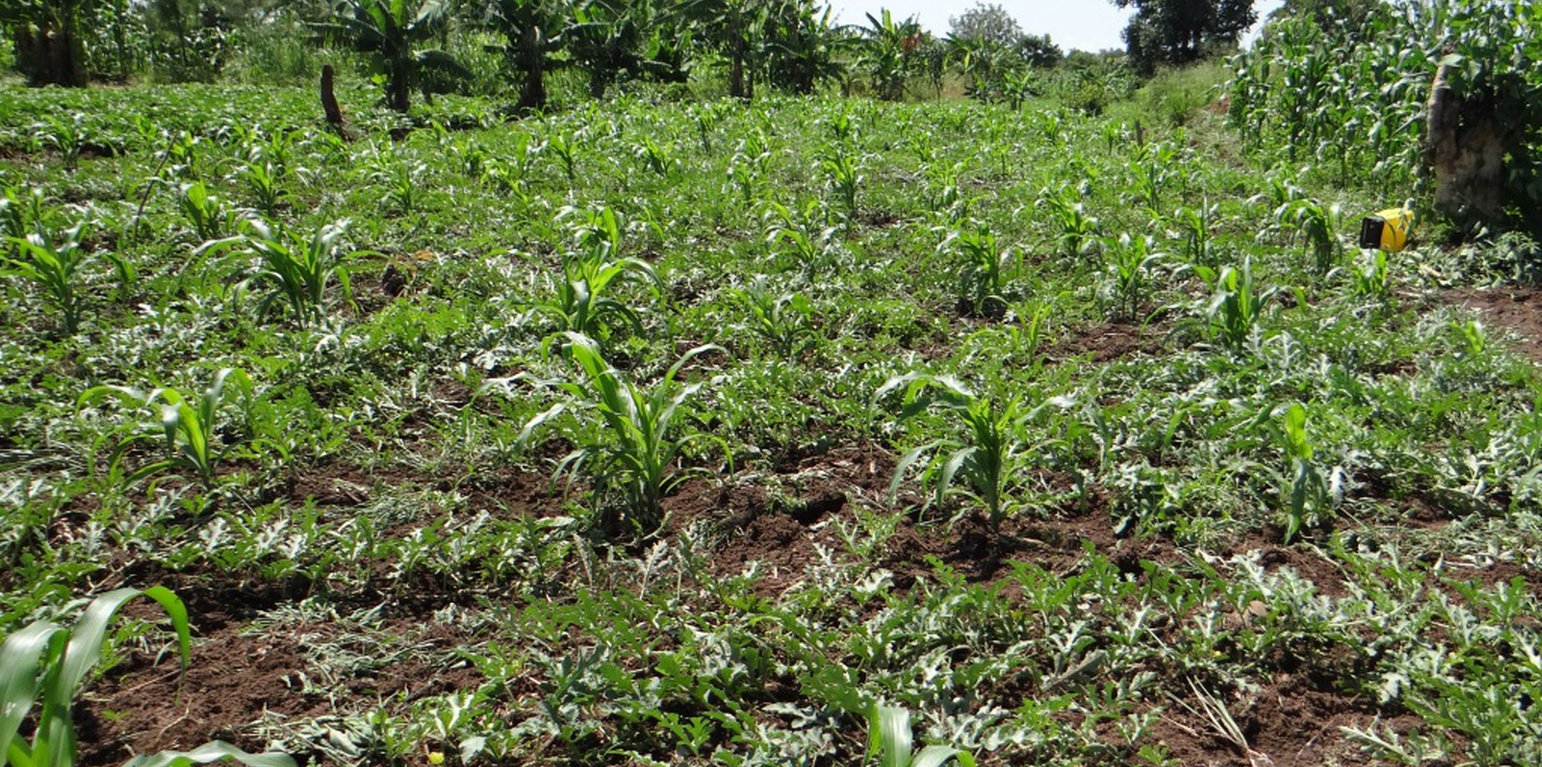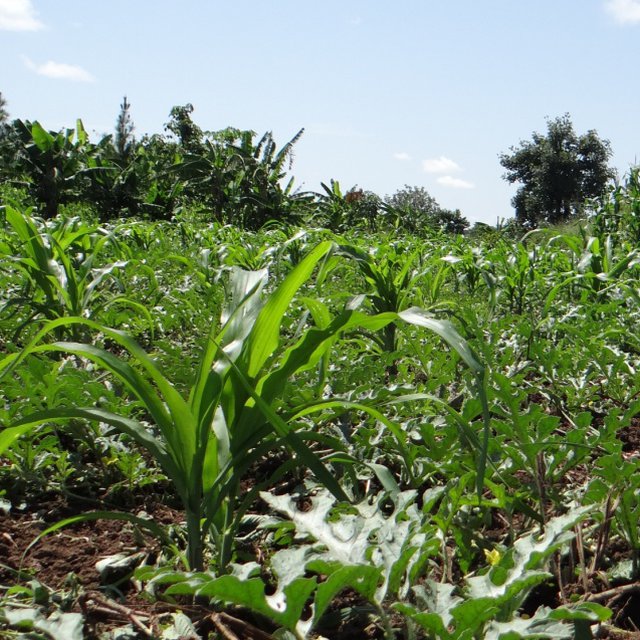



Traditionally, maize has been inter-cropped with other legumes such as common beans or soy bean. Intercropping of maize with water melon is used where the availability of land is limited in order to utilize optimally the available land. Watermelon has emerged as a high-value crop that can replace traditional companion crops in maize cultivations.
The technology is applied by planting maize of 0.25 meters within the rows and 1.0 meters between rows. Watermelon is planted at 1.0 meters meter between individual watermeleon plants. Sugar Baby, the watermelon variety grown in the areas, takes 120 days to mature. It produces melons with bright red flesh. This means that both maize and the water melon are harvested around the same time.
Watermelons like loamy, fertile, well-drained soil. Using a hoe, form mounds of earth (hills) to plant seeds in. Place 3 or 4 holes into the soil with a tool or your finger, about 2.5 cm deep. Place 1 to 4 seeds in each hole, then rake the soil flat over the top of the seeds, and lightly press the soil to pack it sufficiently to keep the moisture from quickly evaporating around the seed. Plant the seed directly into the ground. Keep the soil moist (50-60% moisture content) around the seeds during the germination period, water close enough so that the water reaches the small roots which are in the process of forming. When the seedlings grow, thin them down to the two strongest, to give the strong one room to grow. You should water at least once daily. Mulching soil under the vines helps suppress weeds and slows moisture evaporation.
The major limitation for which farmers detest this technology is that both maize and water melon take a lot of nutrients from the soil that need to be replaced periodically. Since water melon, unlike beans and soy bean, requires spraying, the profitability of this technology may be reduced by these input costs. Furthermore, there are several varieties of water melon that may perform differently in different soils and also have different preferences by consumers. So, there is need to evaluate the market potential of this technology.
Major benefits are increased income, employment, an additional food source, the minimisation of production risks and reduction of production costs by having many fields. The technology increases resilience and income security. Watermelons provide soil cover while maize provides shade to the melons.

地点: Northern, 乌干达
分析的技术场所数量: 单一场所
技术传播: 均匀地分布在一个区域 (approx. < 0.1 平方千米(10 公顷))
实施日期: 2015
介绍类型





技术规范
作者:Bernard Fungo and Amale Balla Sunday
Spacing between maize rows is 1.0 meter. The spacing within rows of maize is 0.25 meter.
Watermelons are planted at a spacing of 3m between rows and 3m within rows i.e. 3m by 3m. Planting for both crops is done by direct sowing at the start of the rainy season. Mulching and is done to reduce the need for weeding and to conserve soil moisture. Spraying of watermelon against fungal infection is done (3 times). The first time one month after planting, the second time when the plants flower and the third time, when the fruits are fully formed. Both crops are harvested after 3-4 months. |
|||||||||||
| 对投入进行具体说明 | 单位 | 数量 | 单位成本 (Uganda Shillings) | 每项投入的总成本 (Uganda Shillings) | 土地使用者承担的成本% |
| 劳动力 | |||||
| Land preparation | Acre | 1.0 | 150000.0 | 150000.0 | 100.0 |
| Pitting and sawing | Acre | 1.0 | 100000.0 | 100000.0 | 100.0 |
| Mulching | Acre | 1.0 | 200000.0 | 200000.0 | 100.0 |
| Spraying | Acre | 1.0 | 100000.0 | 100000.0 | 100.0 |
| 设备 | |||||
| HandHoe for digging | 1 | 4.0 | 5000.0 | 20000.0 | 100.0 |
| 植物材料 | |||||
| Seeds - watermelon | kg | 2.0 | 100000.0 | 200000.0 | 50.0 |
| Seeds - maize | kg | 10.0 | 5000.0 | 50000.0 | 50.0 |
| 肥料和杀菌剂 | |||||
| NPK | kg | 100.0 | 2000.0 | 200000.0 | 20.0 |
| Urea | kg | 100.0 | 2000.0 | 200000.0 | 20.0 |
| Fungicides | Liters | 15.0 | 20000.0 | 300000.0 | 20.0 |
| Knapsack sprayer | Piece | 1.0 | 200000.0 | 200000.0 | 50.0 |
| 施工材料 | |||||
| Mulching material | Bundles | 50.0 | 5000.0 | 250000.0 | 100.0 |
| 技术建立所需总成本 | 1'970'000.0 | ||||
| 对投入进行具体说明 | 单位 | 数量 | 单位成本 (Uganda Shillings) | 每项投入的总成本 (Uganda Shillings) | 土地使用者承担的成本% |
| 劳动力 | |||||
| Planting | Acre | 1.0 | 150000.0 | 150000.0 | 100.0 |
| Mulching | Acre | 1.0 | 200000.0 | 200000.0 | 100.0 |
| Spraying | Acre | 1.0 | 100000.0 | 100000.0 | 100.0 |
| 植物材料 | |||||
| Seeds - Water melon | kg | 2.0 | 100000.0 | 200000.0 | 50.0 |
| Seeds - Maize | kg | 10.0 | 5000.0 | 50000.0 | 50.0 |
| 肥料和杀菌剂 | |||||
| NPK | kg | 100.0 | 2000.0 | 200000.0 | 20.0 |
| Urea | kg | 100.0 | 2000.0 | 200000.0 | 20.0 |
| Fungicides | Liters | 10.0 | 20000.0 | 200000.0 | 20.0 |
| 技术维护所需总成本 | 1'300'000.0 | ||||